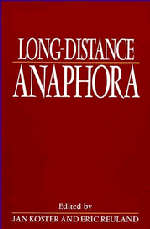Book contents
- Frontmatter
- Contents
- List of contributors
- Preface
- 1 Long-distance anaphora: an overview
- 2 Containment and connectedness anaphors
- 3 Long-distance reflexives and the typology of NPs
- 4 Contextual determination of the anaphor/pronominal distinction
- 5 On the interaction between antecedent-government and binding: the case of long-distance reflexivization
- 6 Binding in Polish
- 7 Anaphors in binary trees: an analysis of Czech reflexives
- 8 Latin long-distance anaphora
- 9 Prepositions, binding and θ-marking
- 10 Locality, parameters and some issues in Italian syntax
- 11 Long-distance binding in Finnish
- 12 The primacy condition of anaphora and pronominal variable binding
- 13 The local nature of the long-distance reflexive in Chinese
- 14 Anaphors and logophors: an argument structure perspective
- References
- Index
2 - Containment and connectedness anaphors
Published online by Cambridge University Press: 01 June 2011
- Frontmatter
- Contents
- List of contributors
- Preface
- 1 Long-distance anaphora: an overview
- 2 Containment and connectedness anaphors
- 3 Long-distance reflexives and the typology of NPs
- 4 Contextual determination of the anaphor/pronominal distinction
- 5 On the interaction between antecedent-government and binding: the case of long-distance reflexivization
- 6 Binding in Polish
- 7 Anaphors in binary trees: an analysis of Czech reflexives
- 8 Latin long-distance anaphora
- 9 Prepositions, binding and θ-marking
- 10 Locality, parameters and some issues in Italian syntax
- 11 Long-distance binding in Finnish
- 12 The primacy condition of anaphora and pronominal variable binding
- 13 The local nature of the long-distance reflexive in Chinese
- 14 Anaphors and logophors: an argument structure perspective
- References
- Index
Summary
Introduction
This chapter articulates the following hypothesis: the conditioning factor for whether an anaphor is ‘long-distance’ or ‘locally’ bound resides in a distinction between what will be called containment conditions and connectedness conditions on anaphors. The hypothesis is based mainly on properties of the anaphoric systems of Norwegian and Icelandic (sections 2.1–2.2), and the importance of the distinction is demonstrated also by interpretive facts concerning Norwegian constructions containing anaphors (section 3). Based on preliminary consideration of long-distance anaphors in certain other languages (section 2.3), our conjecture is that the hypothesis holds universally.
The distinction between containment and connectedness conditions can be seen in the perspective of what relation modules exist in grammar: connectedness conditions deal with what we may call the argument module, i.e. relations defined in terms of the relation ‘argument of’, a module extensively explored in recent work (e.g. Chomsky (1986a) and related research). Containment conditions, in contrast, involve what we will call the command module, a family of relations tied together by a general notion of ‘command’, to be elucidated as we proceed. The significance of containment conditions for anaphors brings to light the status of the command module as an independent and potentially significant module in the grammar.
- Type
- Chapter
- Information
- Long Distance Anaphora , pp. 27 - 48Publisher: Cambridge University PressPrint publication year: 1991
- 9
- Cited by



